I like working on the coop. This past weekend I swapped the raised hen house area of the chicken coop from a straw-bed floor to a sand-bed floor. When I bought our first two hens, who we acquired as grown layers, the owner kept an immaculate coop with a sand bed under the roosting area and swore by that system.
According to Prior Chicken Owner Guy, the sand works basically like kitty litter and you just sweep the chicken poop into a bucket. When the bucket’s full it’s pure chicken manure compost time. If a little sand comes along for the ride, well, who wouldn’t want a bit more sand in their garden beds, huh?
This is what the remodeled Hen House with the new floor now looks like:
It turns out a lot of owners like the sand bed method, and you can find lists of reasons why sand bedding your chickens is a great idea on Backyard Chickens.
But the deep litter method we have been using is great too, and has just as many fans eager to share their reasons for choosing this low-work, compost-in-place method.
Deep littering has worked great in out 12×8 built-on-soil enclosed run, but I haven’t been entirely happy with how it has worked in the elevated 4×8 roosting area. Nothing seems to really compost up there (the litter there never touches the soil, so that makes sense, really), and the lip of our chicken nesting box isn’t high enough to allow the litter to build up anyway. So in practice, that area has needed to be cleaned of roost droppings anyway more-or-less daily.
With this recent coop modification we are attempting a hybrid of the sand bed and the deep litter method. The 12×8 run area will remain deep litter and the hen house will be maintained sand bed style, with a daily scoop-up or rake-out of the overnight poop accumulation.
As I envision it (because I spend so much time envisioning chicken shit), the overnight poop will just be raked down into the run to be added to the rest of the deep-litter compost pile already happening there. If this works, poop maintenance shouldn’t take more than a half-minute a day. If my raking idea doesn’t work I may have to scoop (an action familiar to all cat owners), which would up my maintenance time to 60 or 90 seconds. Either way I think it will be doable.
Making things even easier, Homebrew Husband installed a roof-mounted rake hanger a few months back. A free light-weight rake from my grandma and a pair of screw-in decorative hooks languishing in the garage became an thing of moderate genius, if I do say so myself. If you have a walk-in style coop, I highly recommend this. It has been immensely useful having a rake at the ready on countless occasions.
The hen house sand bed was very easy to install. It took an 8′ length of 2×2 for a sill (so the sand doesn’t just fall out of the hen house) and six bags of sand. We used play sand because it seemed cleaner than riversand, which is pretty stupid reasoning considering the stuff is there to catch poop, but apparently the rougher sand options may have been a better choice. Ah well, live and learn.
The first step was cleaning the floor of the hen house. This wasn’t too hard because we lined the floor with a scrap of vinyl flooring on the advice of a reader. After raking all the hen house straw litter down into the run, a scrub brush and some water took care of most of the poop that had managed to work its way down.
Next I cut the 2×2 to the exact length needed to form a lip at the edge of the hen house. I measured carefully and cut on the long side so I could whittle the lengths down to exactly what was needed for a very tight fit against our coop walls and center-support. A few good whacks got the 2×2 in place.
Everything is just tension mounted so if this experiment fails returning to a shavings or straw litter will be simple.
Once the 2×2 lip was in place I poured in the sand and used my rake to smooth it out. The chickens were out running around in the garden while I did this, and I think I held up their laying schedule a bit because as soon as I wrapped up and stopped making a lot of noise, half the flock lined up for their turn at the nesting box.
Speaking of nesting boxes, I refilled them as well. We’ve been going through old bills and bank statements that we no longer need and shredding a ton of no-longer-important documents. Shredded paper (nothing shiny or glossy) has a million uses around the homestead, so we keep bags of it in the garage until a new worm bin is needed or a gift basket needs stuffing or a fragile package needs protecting in the mail.
I used the old shredded bills to line the nesting boxes and I’m interested to see how the chickens take to it. I like the idea of buying less straw and managing our homestead inputs a little better, and this might be one small way to do that.
The coop has seen one more improvement since we’ve last talked chickens. After reading this post from Apron Stringz, I ran right out and screwed an old tuna can to the side of the coop to hold calcium supplements in the form of oyster shell or recycled egg shells. This has worked great, it’s another highly recommended coop improvement.
Do you tinker with your coop? What things have you modified for the better and what do you still wish you could change?
29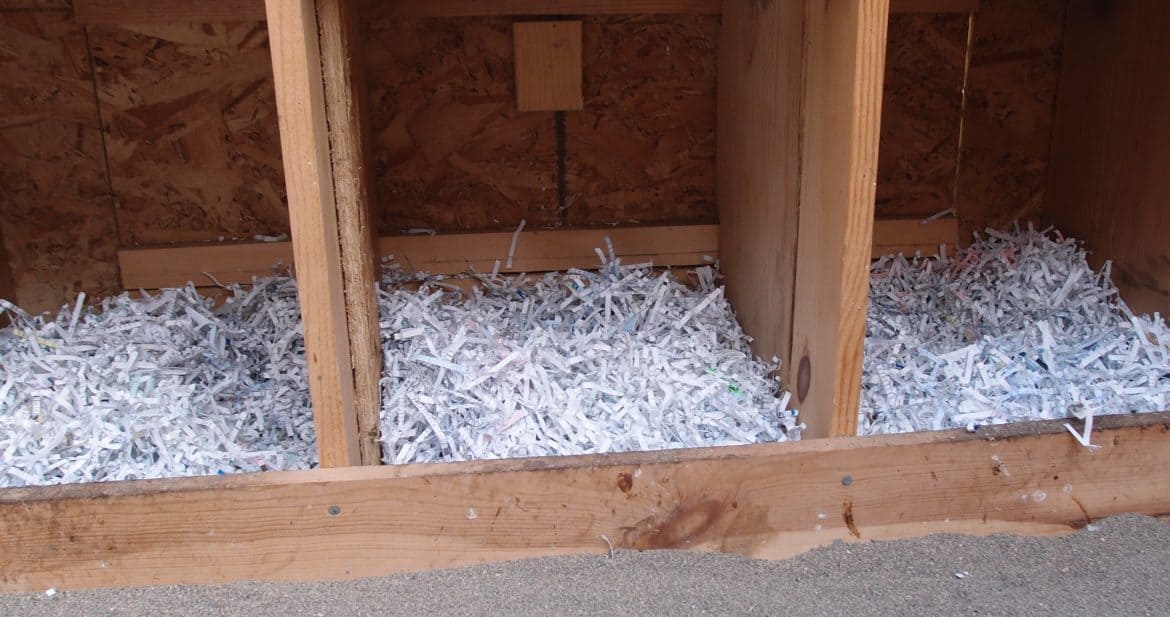
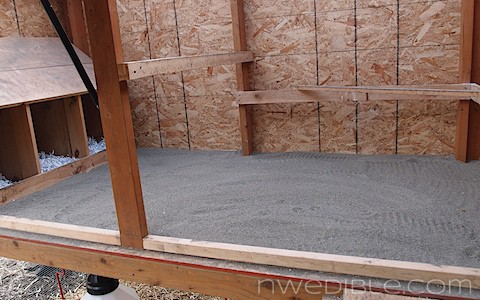
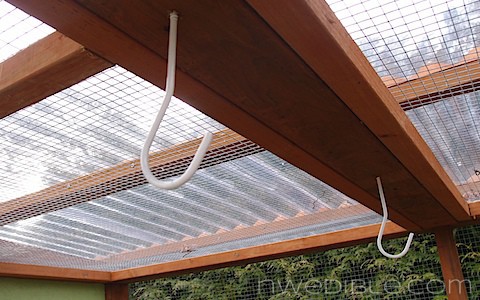
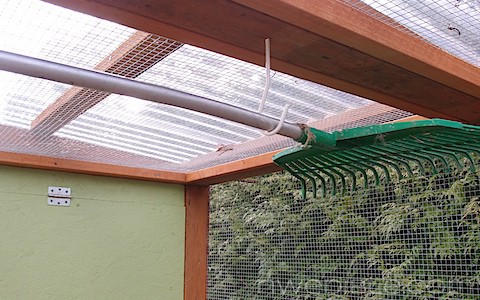
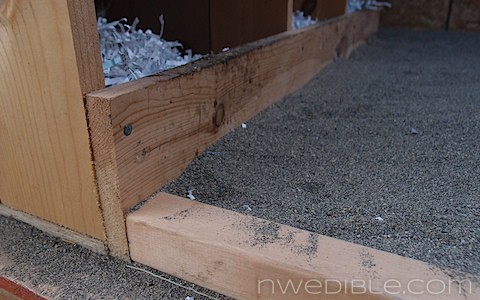
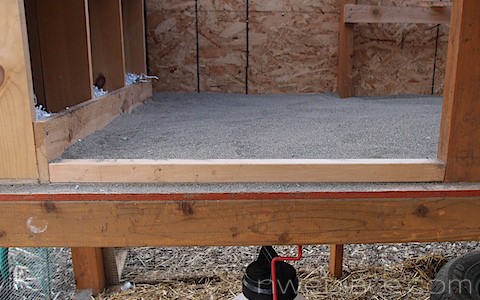
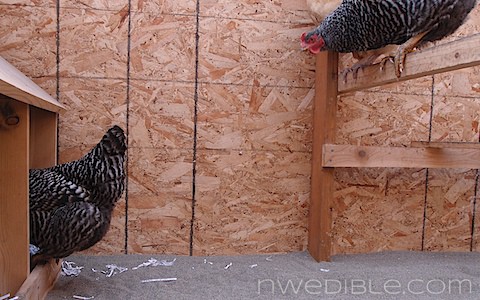
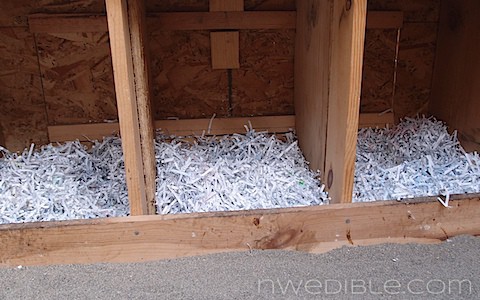
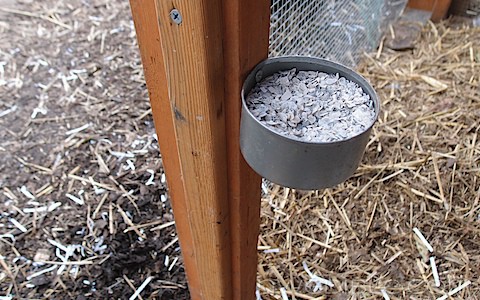
That really sounds like it is going to work the sand floor. I have an old coop with a old plywood floor, have been using shredded bills and old news paper then a layer of straw. Really is hard to clean out and the chickens keep scratching every thing into a circle and most of the floor is bare. Then you know what happens next we get lots of chicken poop on the floor, so it has been a pain for me. I want to try some thing different your plan sounds good. Really liked the pictures. Thanks Ellen from Georgia
It looks like you made them a Japanese rock garden. Perhaps the chickens will start to scratch designs in the sand?
If the hens start drawing out cryptic, impressionistic images, Nazca Lines style, of Erica, me, and the rest of the family, I’m not sure I’ll be able to handle that.
The sands sounds like it’s going to work out great! I usually just put wasted goat hay under the roosts and when it gets too poopy, just toss it into the compost heap. This time around I was lazy and decided to use the “deep bedding method”…….meaning I was too lazy & just put fresh wasted hay over the old stuff. But now that you mention it, I think you’re correct about deep bedding having to have contact with the soil underneath it….and my roost floor is plywood above the ground. Guess I’ll have to give up my deep bedding method. Thanks for the insight though!
By the way, I can’t take sole credit for the rake hanging idea. I was inspired by the way the various necessary tools (ramrods, swabs, worming irons, etc.) would be hung from the deckhead over the fighting decks of a sailing warship, out of the way but ready to hand when needed by the cannon crews. You can see what I mean in a couple of shots in “Master and Commander.”
This will be my first year raising chickens so I appreciate any information I can get my hands on. When I was thinking about building a chicken coop I thought up using sand instead of hay..but this was before seeing anyone use it lol. Maybe I’m smarter than I thought lol.
Coop construction began this last weekend at our house. I’m nervous about the bedding thing. We are converting a garden shed (wooden floor), which I was going to line with linoleum and then deep littler. Suddenly I’m considering a big litter box.
Improvements look awesome! Thanks for the food for thought.
Looks great!
Love seeing your coop. We definitely tinkered with the coop for the first year getting everything just right. My all time absolutely favorite thing is the automatic door we installed. It cost about $90 and was worth every penny. It’s set up on a timer and we can leave for the weekend and I know my girls are out playing all day and locked up safe at night. After six months I am still obsessed with it.
I wonder if the sand will be too coarse for them to effectively dust themselves for mites.
Yeah, it definitely would be, but they wouldn’t dust themselves in this area anyway, it’s just the coop floor under the roosting poles. They dust in the run, in a dusting box, or (more likely) in the fine dry dirt up against the house. They have found little pockets near the foundation they are particularly fond of. 🙂
It’s been 7 weeks or so since you converted to sand – can you give us an update on how it is working for you?
Coming soon! Thanks Marie!
My little hen house is just a cube roughly 4 feet in all directions. There is no floor and while heavy and awkward I am able to move it around even tho it doesn’t have wheels yet. Improvements on the list: wheels, paint (the scrap plywood sides were thin and starting to warp and delaminate) a tin roof and a rain gutter. I love deep litter for all animals because it saves so much time and energy. When I lived in TX I used to be able to get the tree trimmers to drop off at least a couple of truck loads of shredded tree a year. I used that as well as hay the goats wasted in the chicken house. It’s softer than concrete, stays warmer and all the biological activity creates antibiotics and other things that are good for the animals. I cleaned house twice a year, making huge compost piles (8×8 feet x 5ft tall) which really heated up good and hot.
Erica, we are just about to start building a modified version of The Garden Coop as our walk-in-run. We purchased the Eglu Cube and will be attaching to the run. I’ve read just about everything I can on deep litter vs. sand in the run. One day I think sand, the next deep litter… Do you have any smell with the deep litter? Also, what material are you using in the run – hay? Love your blog by the way.
Hi Chicks – no, the smell is very minimal. The only smell issues we’ve had are if the chickens are ranging and poop on something like the back patio – then that has to get washed off because it sticks and is gross. I do like the amount of compost I can harvest from the deep litter method. It requires clean out maybe once or twice a year because the litter gets too deep. I “harvest” compost more frequently, but not because of smell – just because I need the compost! I think people are very happy with either method. Our hybrid system of sand in the coop but deep litter in the run is working really well, too.
Can you post an update on how the change to shredded paper in the nestboxes is going? Do your hens like it this way?
We are in the midst of building the same coop for our chicks that arrive in a couple of days. I envisioned grass then dirt in the run. What is your reason for having the straw down on the ground in the run? Very curious reading about your deep litter composting and leaving it all on the ground. How is the smell? Would you recommend straw and letting it all go versus doing any sort of clean up on a regular basis?
I saw the tip for the vinyl flooring in the coop posted on the gardencoop website for someone who made that suggestion. We plan on doing that too.
Do you welcome visitors or offer tours of your coop?
Thank you!
Hi Miina – I’m working on an update now. Should publish in the next several weeks. If you mean “grass which the chickens will turn to dirt” then you have a fair vision of what the chickens will do. I have straw down over the soil to absorb moisture and poop and to give the hens more to dig and scratch in. The deep litter method has definitely worked well for us in the run. The chickens make great compost for me in there! 🙂
Erica, two hopefully quick questions if you don’t mind. We are buying our lumber for The Garden Coop this weekend. 1.) Do you know what size lumber you used to make the hardware wire roof frames? What a fantastic idea btw – thanks so much for sharing; and 2.) Do you know how wide your purlins are for the roof, the instructions call for 2 x 2 x 12, but like you we are making it it 12′ wide, not certain what the over hang should be? Thank you. Great blog!
Let me take a tape measure out there and check for you. If I don’t report back by Friday afternoon, hit me up with a direct email at nwedible at gmail dot com to remind me.
I appreciate it, thanks so much.
OK, let me know if this answers your questions:
The mesh roof frames and made of 2x2s. There are 3 of them covering our 8×12 coop. Each is approximately 7′ long by 4′ wide and are built with three 4′-wide lengths, one for each end and another at the center. They vary slightly in exact dimensions because they were built to fit *tight* between the roof support 2×4 pieces.
The slanted roof purlins (is that what they are called!? Nifty!) are made from 2x12x12s (I think…potentially we used 14′ lengths but I am pretty sure it was 12′ lengths) cut at that steep angle. Our coop is 8’x12′ and the purlins run across the 8′ length of the coop, so this worked fine. I think to clear 12′ + overhang I’d go with a 16′ length and as wide as I possibly could find….oer 12′, cutting down 12″ wide purlins my concern is your roof angle will not be as steep. There is about a 10 inch overhang from the front of the coop to the front of the truss, and about a 6″ overhang beyond that of the clear panels. But we just eyeballed what looked right. So far that overhang has been fine. We don’t have issue with water intrusion or anything.
Hope this helps. 🙂
Totally helps, I can’t thank you enough!
I want to do a deep litter in the open area of my chicken enclosure its open on all sides basicly it’s a chain link dog run. Is it possible to do it or does it only work in closed off areas? What happens if it rains?
I have been looking EVERYWHERE for something inexpensive to use for grit for my young girls….a tuna can, genius!!! Thanks!!
So it’s about time for our chicks and chickster ( we think we have a rooster) to move out to the big girl pen. After reading your post about deep bed versus the sand method and it’s left me with some questions. Our coop is and old dog run with a concrete floor. There night time roosting and egg laying spot is a modified rabbit hutch up on four legs, it’s in the dog run. What would you use for the floor of the hutch, and what would you use for the dog run floor knowing it’s not dirt? Thanks, tiff
We converted to sand vs. deep litter last month and I LOVE it.
I lost two chickens to heat stroke in June (We had a 106 degree heat spike here in NC).
I was devastated, and remembered reading that the deep litter method generated a lot of heat due to the composting action- so we made the switch when we did our coop rennovation. We also added a thermostat controlled attic fan to the coop to help pull out hot air.
Now I just rake the poop from the area under their roosts and from the enclosed area where there feeder is (they have “free range” of my fenced in back yard during the day) and dump it straight into the compost bin. I am having to think a little more about how to add “browns” to my compost since we are missing pine shavings now, but I’m pleased with the system overall.
I screwed up a leftover coconut shell for the grit/treat mix 🙂
Well sadly I cannot use the sand method and have to stick to straw…. I am terminally ill and am on oxygen 24/7/365 and my doctors have advised me that the sand poses a risk for microscopic dust that could be dangerous for my respiratory system. It does add a tad bit more work but it isn’t as bad as one would think and my coop is kept clean. I spoil my babies. 😀 I love finding new sites to share with and learn from . 😀 There are a LOT of changes I want to make but most are aesthetics. My son (age 19) found 2 old metal milk cans in the woods that had the fronts cut open. He thought he might do something with them (he is a sculptor) but then said “hey mom you think the chickens would like these?” and I said yes! I took them filled with a nice thick layer of straw and they LOVE them. They immediately took to them because they are comfortable, give privacy, and they are on the second story away from the geese.
Hi there! Just a word of caution with this, the article states: “who wouldn’t want a bit more sand in their garden beds, huh?” Well, someone with clay soil definitely does not, when sand is mixed with clay it basically creates concrete, an makes even poorer drainage. I luckily learned this from a horticultural educator/master gardener from Cornell University.
How does that strand board work out for your coop? Does it keep water out? We’re trying to find the least expensive wood to use to build ours. TIA!
Thank you so very much for documenting your experiences and lessons learned. I am close to embarking on the backyard hens journey, and I plan to use something like The Chicken Coop with your hybrid sand and deep litter method.
Any updates since you started two years ago? Is the compost working out? Still no smell issues?
Thanks for any additional info you could provide!
I am tinkering in my coop ALL THE TIME!! I am in the process of turning an unused 8×10 out building into a new BIGGER and BETTER coop! I know very little about construction but I have been learning a LOT as I go along. I refuse to allow my husband to help as there is only one opinion I want on the final product – mine! HA! I love the idea of sand under the roosts – I will add some diatomaceous earth to dry up the droppings and eliminate the smell. I use it mixed in with the wood shavings in my small coop now and it works GREAT. Thanks for the tips – I will be using some of these in my new coop!
You actually make it appear so easy with your presentation but I to find this
topic to be actually one thing that I feel I would by no means understand.
It kind of feels too complex and very wide for me. I’m taking
a look ahead for your subsequent submit, I will attempt to get the grasp of it!
What brand of sand do you use and where can I buy it